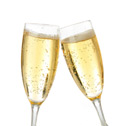


- MAKE YOUR OWN EXHIBIT
- WATCH A VIDEO
- READ A BLOG
- TACTILE & BRAILLE HTE
- AMERICAN SPACES
- PIN SOME IMAGES
- SHARE WITH A FRIEND

Science in a Champagne Flute
January 10, 2013

With the recent change of the calendar at New Year's, we wanted to touch on an important aspect of the holiday: bubbles. Whether you like your bubbles in Champagne, beer, sparkling cider or something else, the passing of one year into the next is often noted with something yummy to drink containing bubbles.
Alan Boyle, who writes the Cosmic Log on NBCNews.com, recently had a post on the science of bubbles just in time for New Year's Eve.
In his article, Boyle quotes Gerard Liger-Belair, a physicist at the University of Reims in France, who studies, among other things, how bubbles in Champagne behave. Liger-Belair says:
"In fact, bubbles are a fantastic example of bubble dynamics in general, and studies dealing with champagne bubbles can be extended to many other areas where bubbles play a role, in natural as well as industrial processes. For example, marine aerosols created by bursting bubbles behave like champagne's bursting bubbles. ... The scales are different, but the basic principles are identical," he said in his email.

Here at HTE, we say "cheers" to the idea of looking at phenomena across different scales. In fact, we are curious how the science of bubbles in Champagne compares with bubbles found, say, in the heart of a galaxy cluster. If you have thoughts on the matter, please let us know. And, if anyone out there needs volunteers with testing a hypothesis involving interstellar space and a delicious bubbly drink, be sure to get in contact with us. We'll be glad to help.
-Megan Watzke, Chandra/HTE

"Here, There, & Everywhere" (HTE) is supported by the National Aeronautics and Space Administration under grant NNX11AH28G issued through the Science Mission Directorate.
HTE was developed by the Chandra X-ray Center, at the Smithsonian Astrophysical Observatory, in Cambridge, MA.
Email: cxcpub@cfa.harvard.edu | Phone: 617.496.7941
Follow us: #HTEScience on Twitter